P7791
Prazosin hydrochloride
≥99.0% (HPLC), powder, α1-adrenoceptor antagonist
Sinónimos:
1-(4-Amino-6,7-dimethoxy-2-quinazolinyl)-4-(2-furanylcarbonyl)piperazine hydrochloride, Furazosin hydrochloride
About This Item
Productos recomendados
product name
Prazosin hydrochloride, ≥99.0% (HPLC)
assay
≥99.0% (HPLC)
form
powder
solubility
H2O: 0.5 mg/mL
methanol: 6 mg/mL
dilute aqueous acid: insoluble
SMILES string
Cl.COc1cc2nc(nc(N)c2cc1OC)N3CCN(CC3)C(=O)c4ccco4
InChI
1S/C19H21N5O4.ClH/c1-26-15-10-12-13(11-16(15)27-2)21-19(22-17(12)20)24-7-5-23(6-8-24)18(25)14-4-3-9-28-14;/h3-4,9-11H,5-8H2,1-2H3,(H2,20,21,22);1H
InChI key
WFXFYZULCQKPIP-UHFFFAOYSA-N
Gene Information
human ... ADRA1A(148) , ADRA1B(147) , ADRA1D(146)
¿Está buscando productos similares? Visita Guía de comparación de productos
General description
Application
- to block the α1adrenergic receptors that mediate sympathetic vasoconstriction in mice
- as an α1-adrenoceptor blocker,administered intragastrically in rats
- as a vasodilator,administered together with inuslin into the left ventricle of mice for the assessment of its effects on renal functions
Biochem/physiol Actions
Features and Benefits
Packaging
Caution
signalword
Warning
hcodes
Hazard Classifications
Repr. 2 - STOT RE 2 - STOT SE 3
target_organs
Central nervous system
Storage Class
11 - Combustible Solids
wgk_germany
WGK 3
flash_point_f
Not applicable
flash_point_c
Not applicable
ppe
dust mask type N95 (US), Eyeshields, Gloves
Certificados de análisis (COA)
Busque Certificados de análisis (COA) introduciendo el número de lote del producto. Los números de lote se encuentran en la etiqueta del producto después de las palabras «Lot» o «Batch»
¿Ya tiene este producto?
Encuentre la documentación para los productos que ha comprado recientemente en la Biblioteca de documentos.
Los clientes también vieron
Artículos
Gain a deeper understanding of the various types of receptor agonists and antagonists, including full, partial, and inverse agonists and competitive/reversible and non-competitive/irreversible antagonists.
Review alpha 1 adrenoceptors as well as their agonists, antagonists, and tissue expression patterns. We suggest several modulators and alternatives for working with a-1 adrenoreceptors.
Learn about alpha-2 adrenoceptor and its subtypes, mediated responses, and applications of agonists. Included is a list of available products and a comparison table.
Discover Bioactive Small Molecules for ADME/Tox
Nuestro equipo de científicos tiene experiencia en todas las áreas de investigación: Ciencias de la vida, Ciencia de los materiales, Síntesis química, Cromatografía, Analítica y muchas otras.
Póngase en contacto con el Servicio técnico















